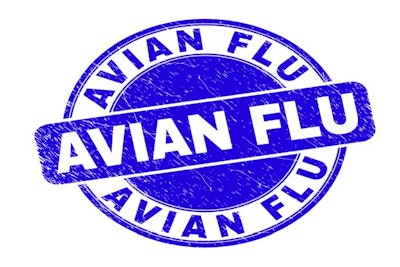
A recently published study helps to explain the Dutch authorities’ recent change in approach to the control of highly pathogenic avian influenza (HPAI) the Gelderland.
Earlier outbreaks in poultry flocks were traced back to different wild birds. However, the ongoing wave of outbreaks in one area of this eastern province indicate that the virus was spreading from one poultry flock to another. Evidence came from genetic analysis of the virus isolated from affected farms, according to Wageningen Bioveterinary Research (WVBR), which is linked to Wageningen University.
The spread of the H5N1 serotype of the HPAI virus on farms in the area of Lunteren was described as a “horror scene” by WVBR’s avian flu expert Nancy Beerens in a recent interview. She said that genetic analysis of samples collected from affected farms in this poultry-dense area revealed the viruses were very closely related. This suggests that the infection was spreading directly from one farm to the next, she said.
In recent weeks, all poultry farms within 1km of a known infection have been depopulated, and the birds destroyed. These procedures are now carried out with particular caution in order to contain potentially infected materials such as dust and feathers, according to Beerens.
Also affected by this change in approach to HPAI control in the Netherlands is the introduction of intensified surveillance of poultry farms between one and three kilometers from the known outbreak. Monitoring now continues for 14 days on all premises with poultry in that zone.
Since the start of April, the Dutch agriculture ministry has confirmed 11 HPAI outbreaks in the province of Gelderland (up to May 2). Of these, seven were near Lunteren. Majority of cases have been in laying hens, but breeding chickens and ducks have also tested positive for the H5N1 virus over this period.
Since the virus was first detected in October last year, more than 2.4 million poultry in the Netherlands have been directly impacted by HPAI outbreaks.
Confirmed outbreaks in European poultry pass 1,500
As of April 29, 1,526 HPAI outbreaks have been registered across Europe so far in 2022. This is according to the latest update of the Animal Disease Information System by the European Commission (EC), and it includes one or more outbreaks in 18 European countries over this period.
As more outbreaks are confirmed, this total draws ever closer to the total of 1,756 outbreaks registered with the EC by 24 European states during the whole of 2021.
Of the 97 new outbreaks recorded since the previous update on April 22, 62 were recorded in France. These bring this nation’s total so far this year to 1,265 outbreaks
With 21 more outbreaks confirmed by Hungary, this nation has registered the second highest outbreaks total for 2022 so far at 65. With an increase of seven, the Netherlands’ total has risen to 33, while Spain’s remains unchanged at 31 for the year so far.
French govt says HPAI progression is slowing
Over the past week, France has officially registered further HPAI outbreaks in poultry linked to the H5N1 virus serotype.
According to notifications to the World Organisation for Animal Health (OIE), the number of the nation’s poultry directly impacted by outbreaks since November of last year is approaching 14.9 million. This figure includes birds in commercial poultry flocks that died or were culled as a result of an outbreak on the infected premises.
A further 1,612 poultry have been involved when the virus was detected at other premises, such as backyard flocks and zoos.
While the spread of the disease continues to spread in western France, its progression is slowing, according to the agriculture ministry. In the Pays de la Loire region, particularly strict measures were put in place to protect breeder flocks and hatcheries in this important area for the French poultry industry.
Only recently were the first cases of HPAI detected on commercial farms in the northwestern region of Brittany. To control the spread in this region, commercial duck farms were depopulated in a 10-km-wide strip, the ministry reports.
Iceland registers first cases in poultry
In mid-April, a backyard flock tested positive for the H5N1 HPAI virus in Iceland.
After one of the birds died, the remaining 11 poultry were culled, according to the OIE notification.
Authorities report that some nearby wild birds had previously tested positive for the same virus. As the holding is isolated from other poultry, the disease situation in poultry has been declared “resolved.”
New outbreaks recorded in central European poultry
Following a brief hiatus, Hungary has reported the return of HPAI since mid-April. Commercial poultry — particularly ducks and geese for meat or foie gras production — have tested positive for the H5N1 serotype in three southern counties.
Since the end of April, 36 new outbreaks have been registered with the OIE, involving a total of around 600,000 poultry.
Already more than 1.08 million poultry have been directly affected by the outbreaks in the country over a period of around two weeks.
Meanwhile, a further seven HPAI outbreaks have been confirmed to the OIE by the veterinary authority of Bulgaria.
Of these, six were near Slavyanovo in the northern province of Pleven, while the other cases were in Stara Zagora. Affecting large commercial farms, an H5 virus is suspected but it has not been typed.
Together with one recent outbreak in Plovdiv, these bring to eight the number of outbreaks in Bulgaria since April. Directly impacted have been almost 420,000 commercial poultry.
Poland’s total outbreaks so far this year has reached 30, reports the nation’s chief veterinary office. Most recently testing positive for the H5N1 virus was a flock of around 34,500 meat turkeys. The farm is located in the same district of Greater Poland (Wielkopolskie) as the two previous confirmed outbreaks.
Rising HPAI cases in European wild birds
For the year to date, HPAI outbreaks in wild birds across Europe reported to the EC notification system have reached 1,633 (as of April 29).
This represents an increase of 21 compared with the previous week. Of these, 13 were reported by Germany, which accounts for 817 or around half of the regional total.
Also confirming with the EC new outbreaks over the previous seven days were Denmark, Finland, France, Lithuania, and Spain.
At the end of April, Russia’s veterinary agency declared to the OIE that HPAI had been brought under control in Astrakhan. In this region in the Southern federal district, nine pelicans tested positive for an HPAI virus of the H5 family during March.
View our continuing coverage of the global avian influenza situation.

















